Reader Alsadius visited Portsmouth in August 2018, and has agreed to share his experiences here.
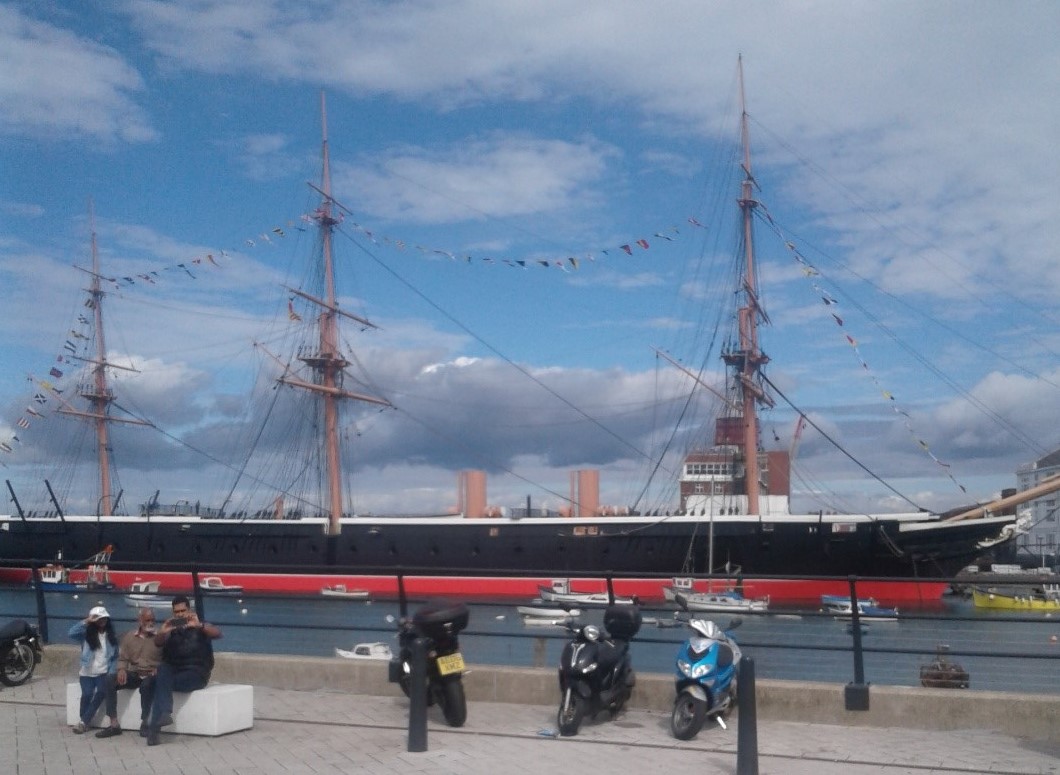
The ironclad, in its natural habitat.
The Portsmouth Historic Dockyard is a deeply impressive collection of ships. The highlights are:
1) HMS Victory (1765), the oldest commissioned ship in the world, famous for being the flagship at Trafalgar, and technically the flagship of the First Sea Lord even today. 2) HMS Warrior (1860), one of the first metal ships built, and Britain’s first ironclad. 3) Mary Rose (1511), a carrack that sank in 1545 and was raised in 1982.
There’s also several less prominent exhibits.
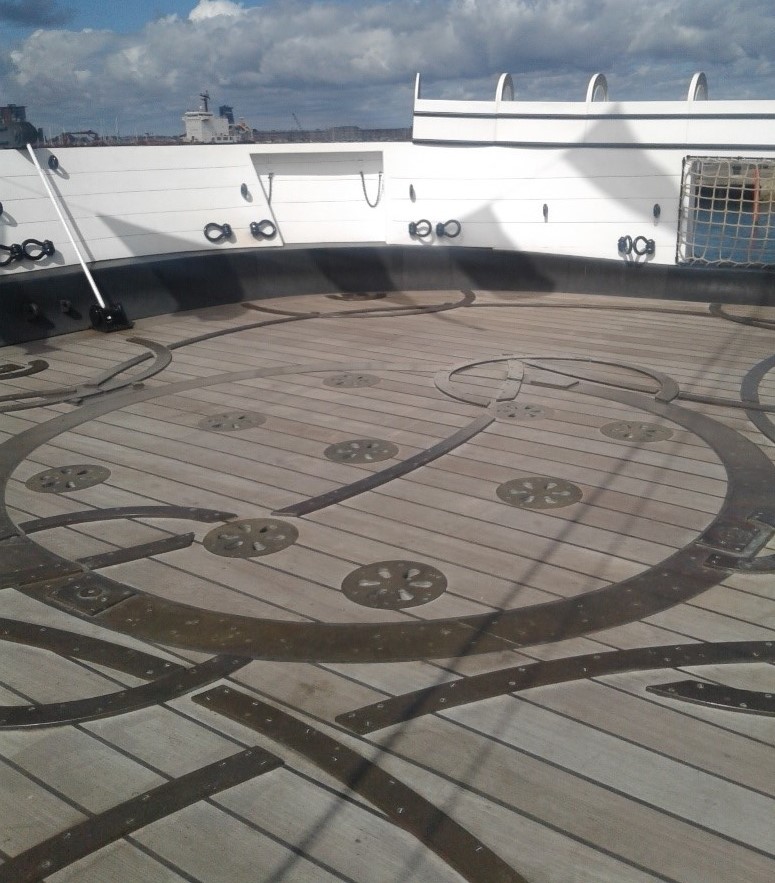
Metal guide rails built into the deck, for pivoting the chaser guns.
Because the tickets at the time I went didn’t include the Mary Rose without paying extra, we didn’t wind up seeing it. We visited Warrior, Victory, and the National Museum of the Royal Navy.
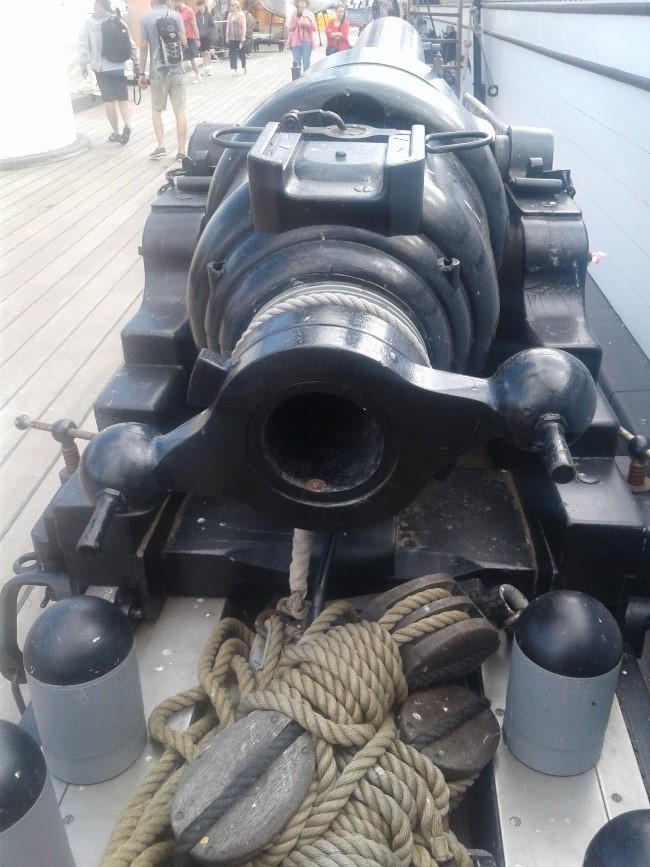
A replica gun, with some replica ammunition and tackle.
First things first, this is a gigantic time sink for naval geeks. We spent over six hours there, just on those three attractions, plus an extra three hours getting back and forth from London. If you want to do justice to it, give it a really solid day, or maybe even two. And if you have any travelling companions, I hope they’re as enthusiastic as you, or as patient as my wife was. (We went here the day after HMS Belfast, and she is not a naval geek. I am a lucky man.) First on our list, because she’s nearest the front of the dockyard, was Warrior.
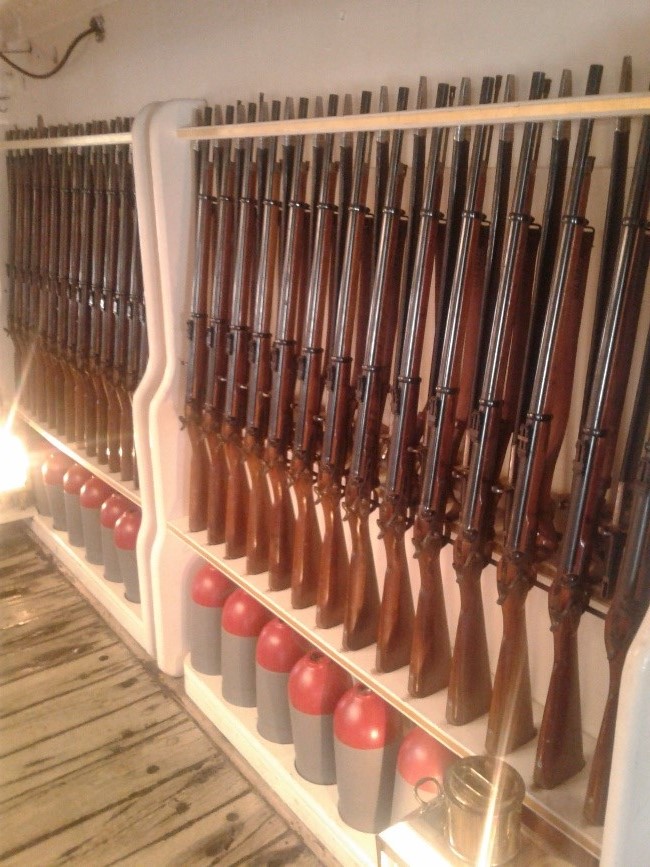
One of the many arms racks throughout the ship, with more ammunition.
Warrior was a response to the French Gloire of 1859, which promised to be immune to the firepower of the British navy (as was so famously demonstrated by ironclad combat in the US Civil War). Queen Victoria personally started asking if the navy could handle a war, so Warrior and her sister Black Prince were built to address the threat. They were rapidly overtaken by advancing technology, and never saw combat, being withdrawn from front-line service in the mid-1870s.
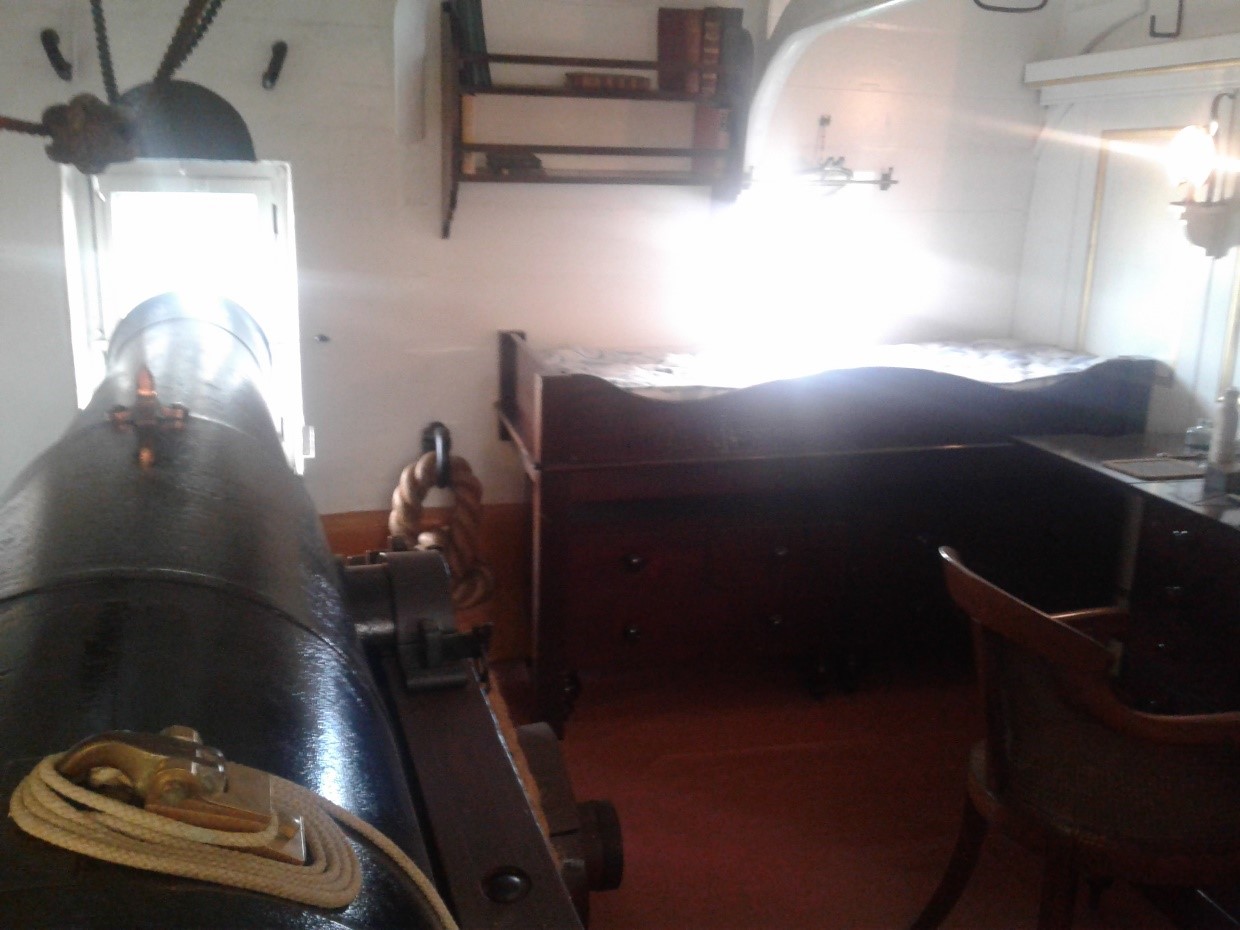
Incongruous gun placement.
Warrior carried 10x 110-pdr rifled guns, 26x 68-pdr smoothbores, and 4x 40-pdr rifled guns, was armoured with 4.5” of wrought iron over 18” of wood, and could make 14 knots under a combination of steam and sail. She weighed 9,137 tons, and had a crew of 706.
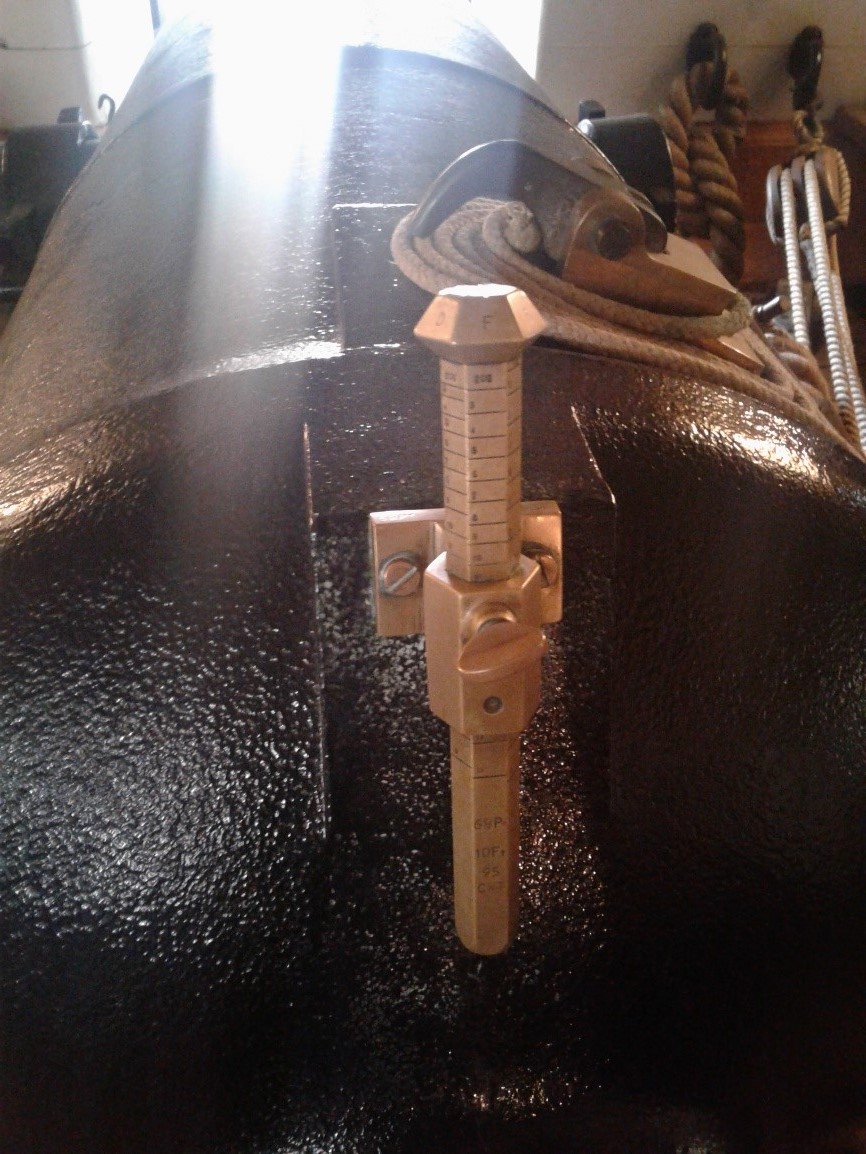
High-tech 1860s fire control systems.
Warrior was a fairly sparse tour in many ways. Not a ton of signage, and comparatively few guides. What they did have was decent, but there was a lot of it where it was just you and the ship.
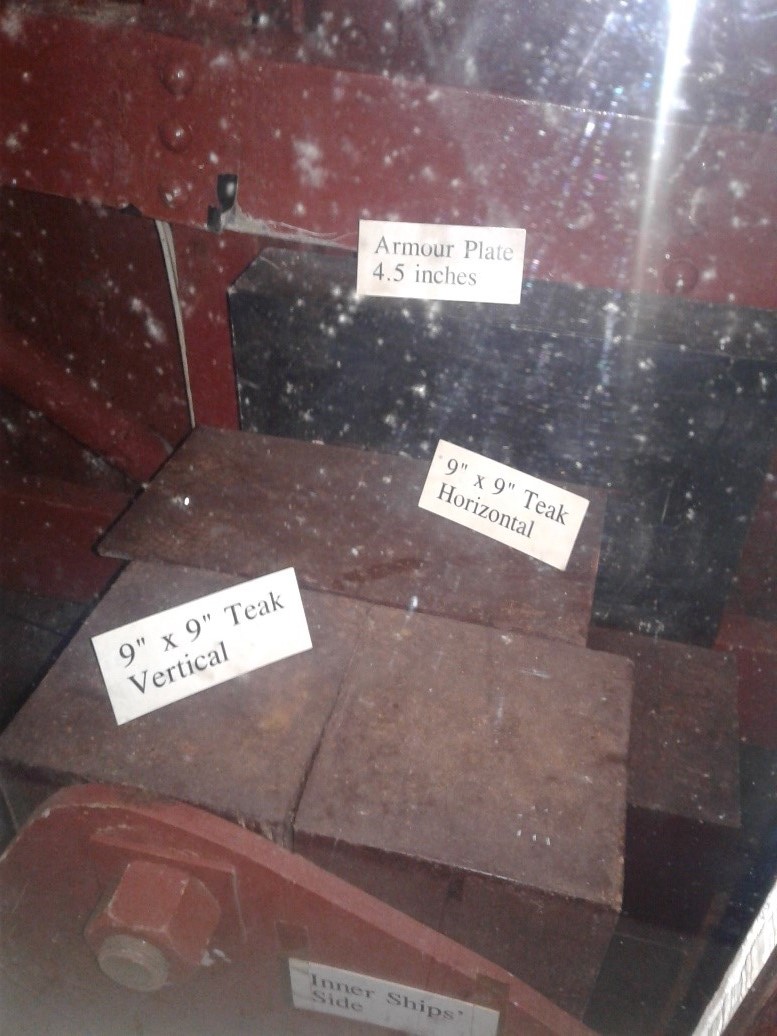
A model of the ship’s armour scheme.
A chalkboard for tracking the coal use of the boilers.
After Warrior came Victory. Victory is not actually afloat, and hasn’t been since 1922. She’s in the world’s oldest active dry-dock, because her condition is so poor that she can’t be left in the water. Even before Napoleon was defeated, she was so old that she got withdrawn from active service, being moved down successively from first-rate to second-rate, troop ship, floating depot, and by 1813 a mere prison ship. By the 1880s, you could apparently poke a stick through her sides, and her condition was “nothing short of an insult” by 1911. Post-WW1, a public campaign to save her resulted in her being dry-docked, where she remains to this day.
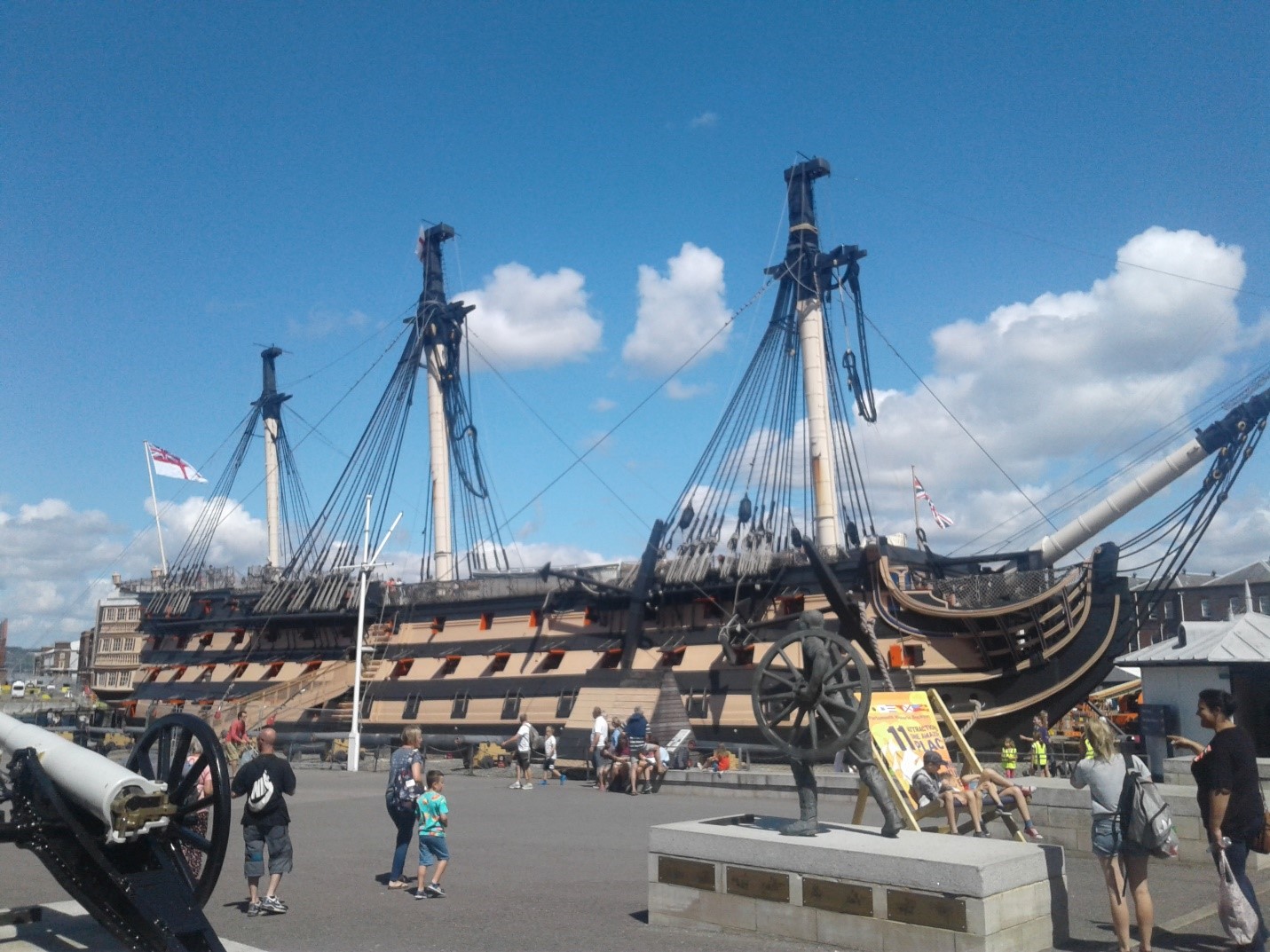
Even once Victory was out of the water, preserving her was a real struggle. She needed so much structural work that it took over 80 years to restore her to Trafalgar-era appearance. (Being hit by a German bomb in 1941 and having her keel broken didn’t help either). Even the process of dry-docking her for a century was rough on the ship, with the usual dry-dock supports being too few for really long-term preservation, and the ship’s timbers developing something of a wave pattern as the weight bore down on a small number of frames for a hundred years.
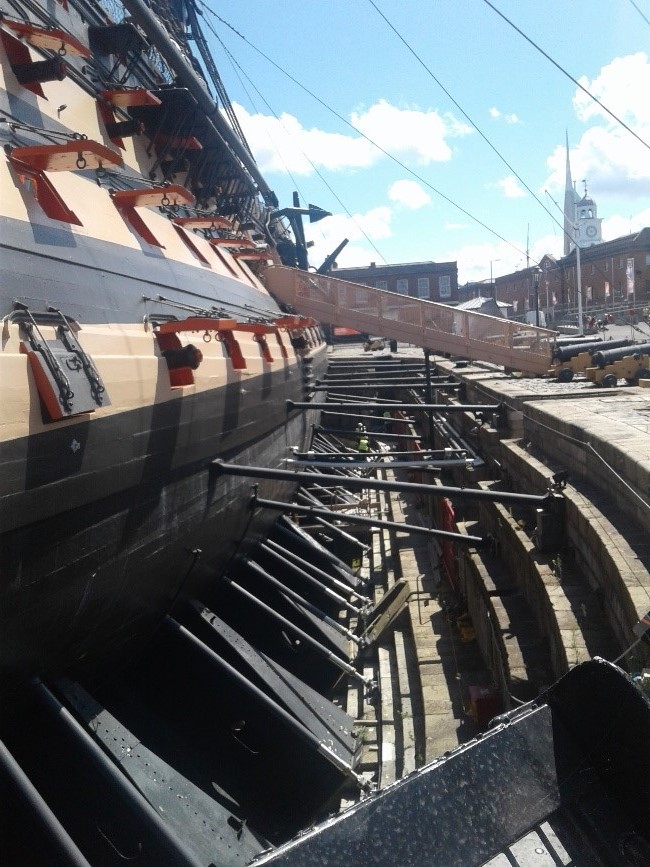
The large metal supports are the old system, with the stick-like things being a relatively new addition to distribute the weight better and let things settle to a proper shape.
The ship herself was a first-rate ship of the line, and was one of the strongest Royal Navy vessels during her life. At Trafalgar, she carried 104 guns – 30x 32-pdr, 28x 24-pdr, 44x 12-pdr, and 2x 68-pdr carronades. She weighed 3500 tons, and carried a crew of about 850. (A staggering number for a ship so small, which gets very clear when you see how tight the sleeping arrangements were)
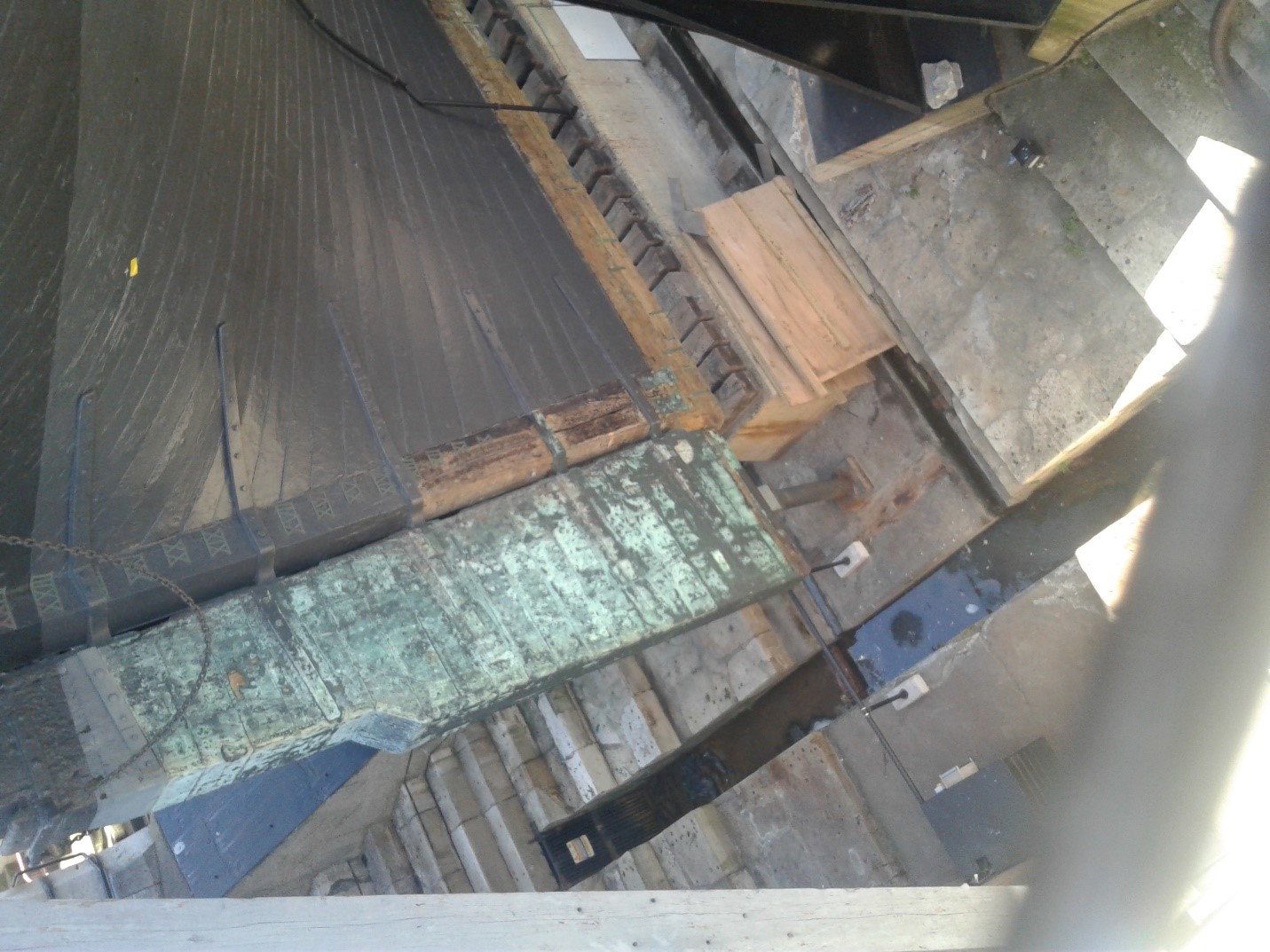
The rudder is one of the few bits believed to be a 1765 original piece, not restored at any point thereafter. It looks the part.
One nice thing about Victory is that basically the entire ship is accessible. You can go into the admiral’s cabin, see the carpenter’s shop, the magazines, and even the lower holds. The lighting down there is very dim, so I don’t have any worthwhile photos, but…well, it’s a hold. There wasn’t much to photograph.
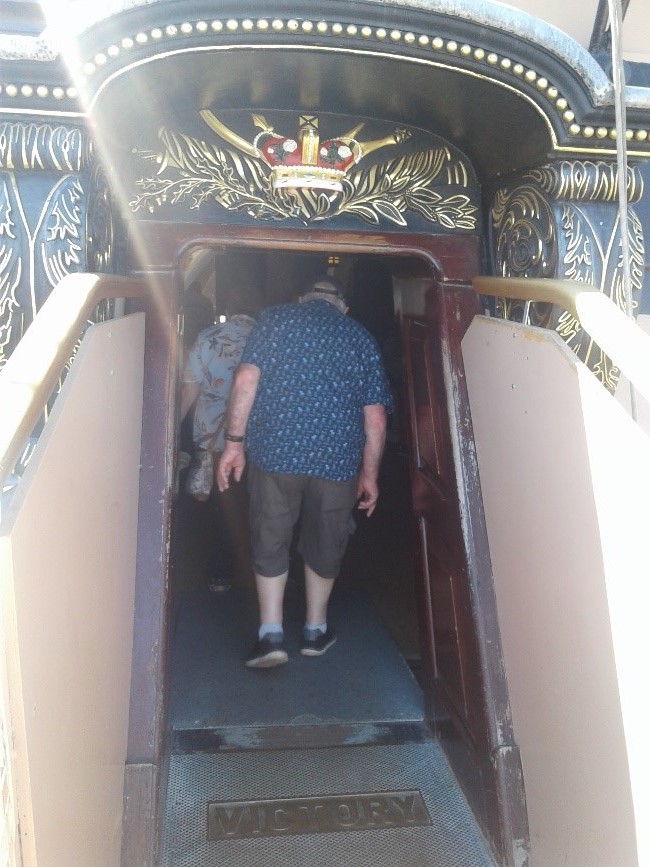
Everything about the ship is small, even its main entrance. But also pretty.
There were more guides on Victory, including one very nice (if rather shy) lady that I spent some time talking to. But the signage was, if anything, even weaker than on Warrior. They’re really leaning on the ship itself to carry the story of the visit. If any ship can, it’s Victory, but after coming off of Belfast the previous day, I was rather disappointed by it.1

Me, below-decks, with my head between two beams. I’m 6’3”, standing flat on the ground. I was just happy to be able to stand up straight, however briefly and ridiculously. The ship is small.
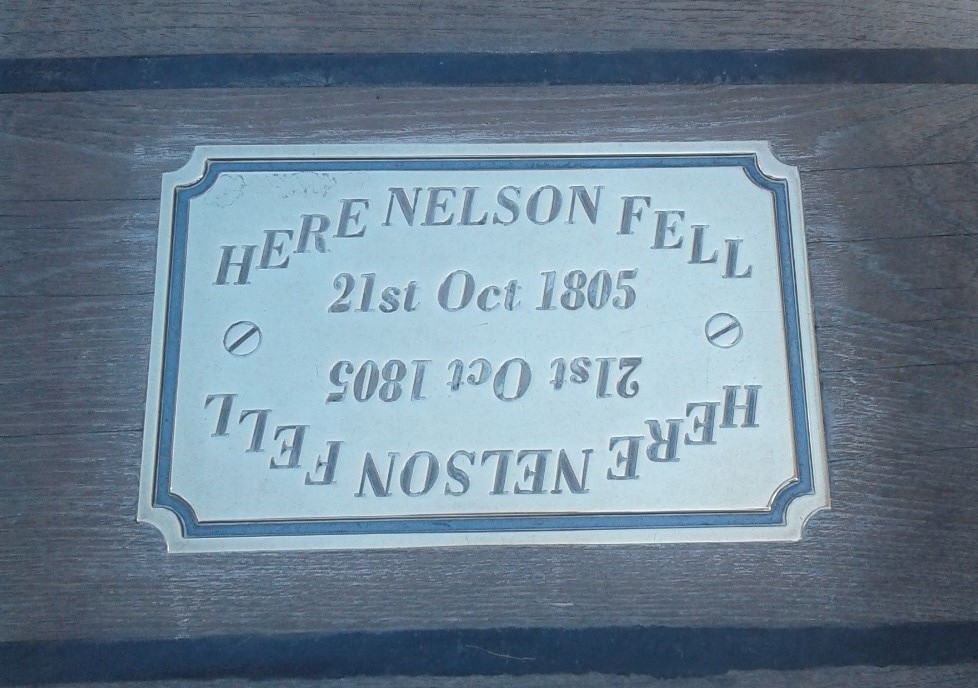
Pictured: An event of some small historical importance.
One other fun thing about it, albeit shared by a lot of major naval museums, is that it’s also a working port, and indeed one of the Royal Navy’s main ports. We were lucky enough to have the Queen Elizabeth in port the day we went – obviously, for an active capital ship, you can’t look up when it’ll be around, but it’s there sometimes. That was good fun.
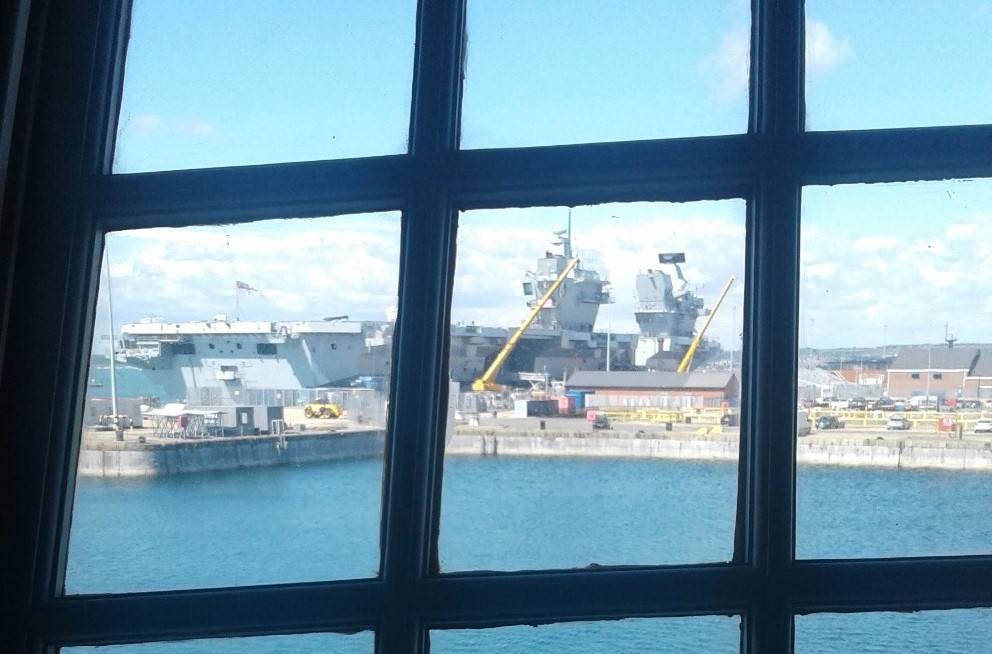
Pictured: The Royal Navy’s newest ship, as seen from her oldest. (These windows were in the admiral’s wardroom)
After that, we went for the museum. From looking around after the fact, it seems that the museum is spread across three buildings, and we only saw one, so this isn’t going to be a review of the whole thing.
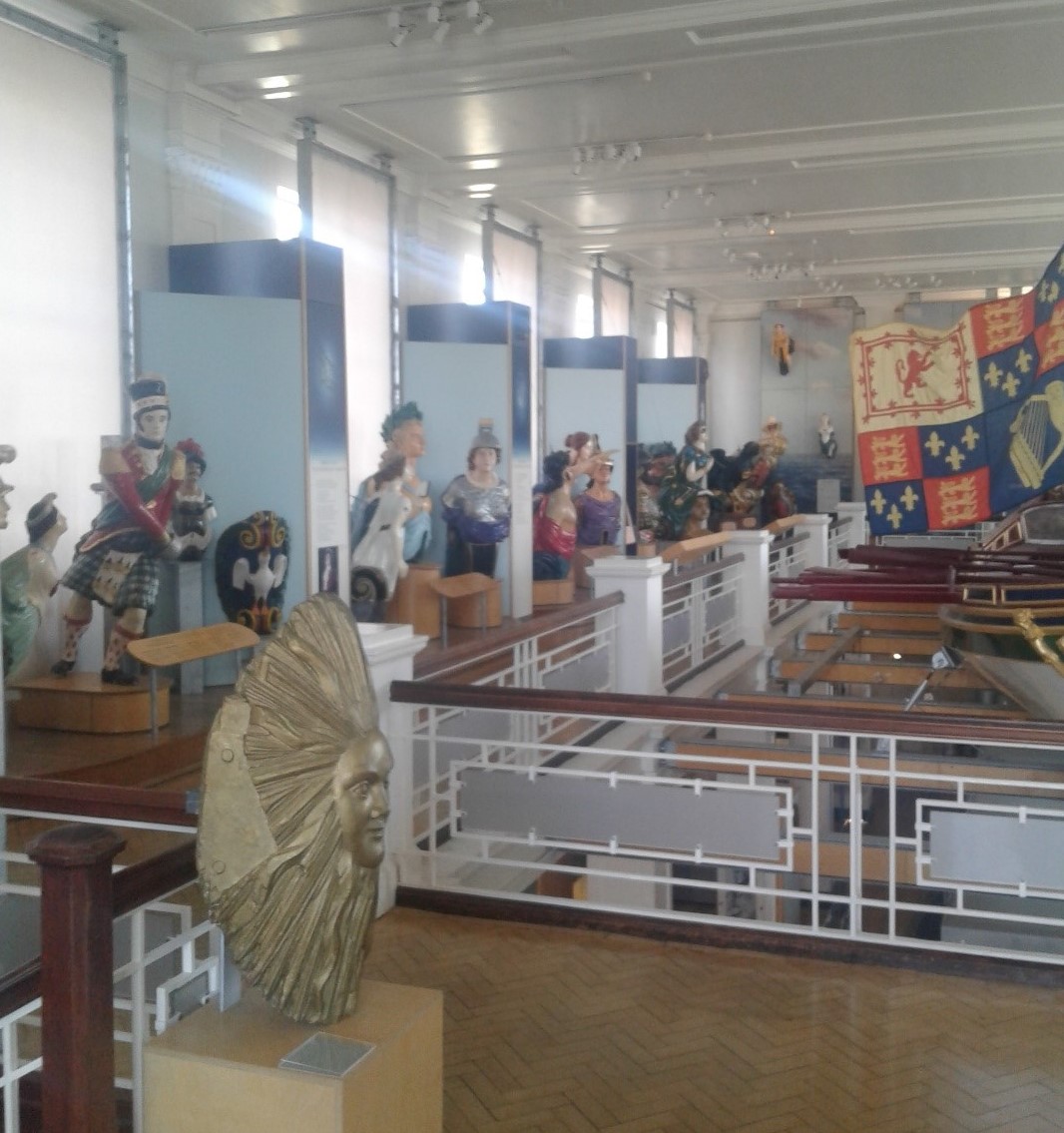
They’re not real ships, they’re just figureheads.
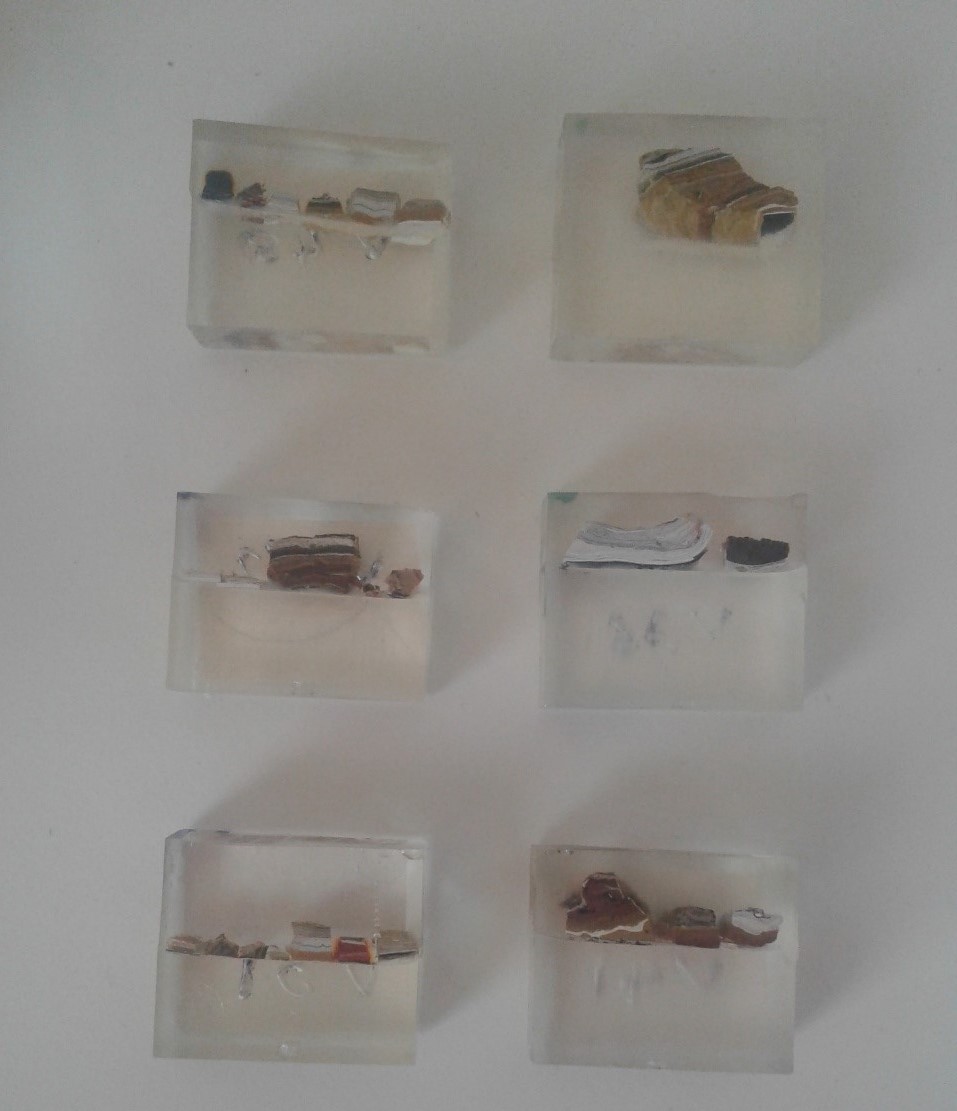
Paint samples taken from Victory during her restoration process. Some were up to 72 layers thick.
In short, it matched the other parts of Portsmouth – fantastic collection, mediocre execution. Most of the space we saw was dedicated to Victory’s preservation process, and to the world’s largest collection of ship figureheads.
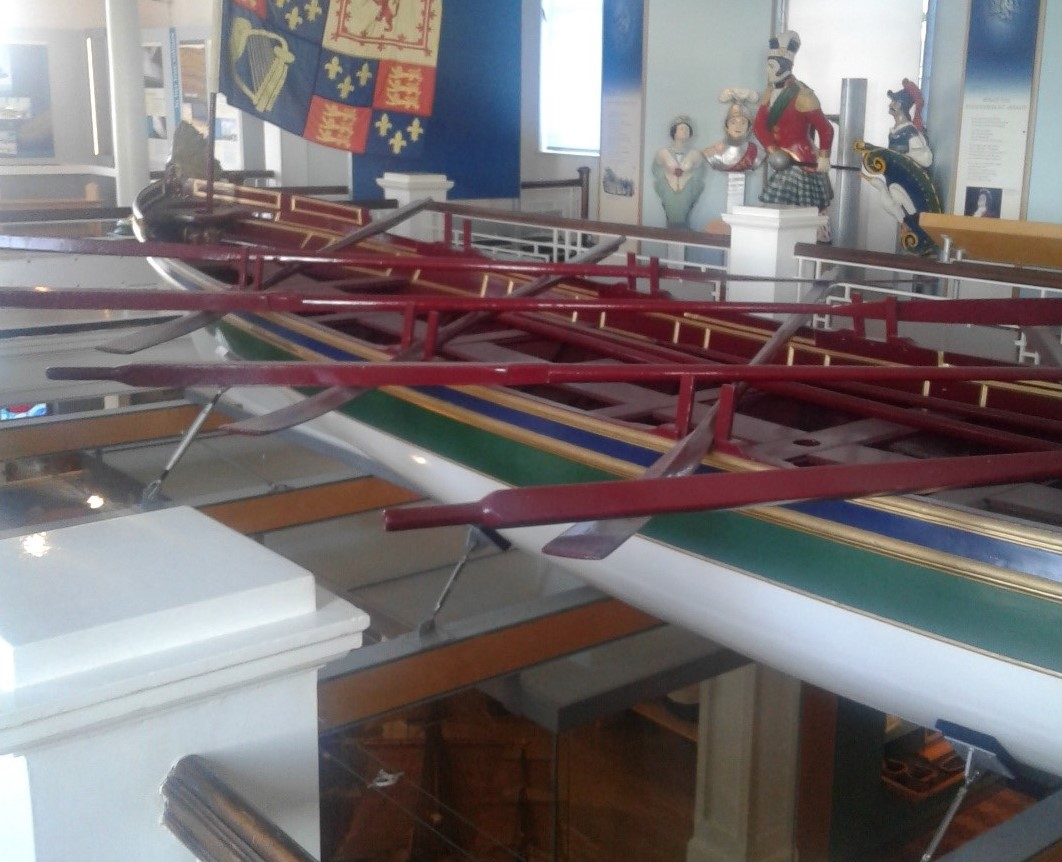
The royal barge of King Charles II, built in 1670, is the oldest extant ship of the type. It’s currently suspended in the middle of the room.
On the whole, most readers of Naval Gazing would be expected to enjoy it. A lot of very important ships live here. But they could do a lot better with the marvelous collection they have. I was expecting this to be a solid 5.0, and it just didn’t quite manage it.
1 Bean: This is reminiscent of my experience aboard Constitution, which had a similar problem. ⇑

Comments
Aye, I also visited in 2016, and am mostly in agreement about the fantastic collection with somewhat underwhelming execution. The Mary Rose museum was well worth it for me, with excellent signage and labelling of artifacts. The Jutland collection was also solidly done, although without any of the actual ships, it relied heavily on small artifacts, medals, flags, and paintings.
I went as a boy in the late 90s, and it sounds like very little has changed on the signage front, although it looks like the restoration has improved significantly since then.
Sailors gonna sailor, even in the days of sail.
I have pulled into Portsmouth, and saw HMS Victory while there. Twas pretty cool.
There are also lots of other Naval/Maritime/military museums close by:
D-Day museum (Southsea) Explosion! Museum of Naval Firepower (Gosport) Submarine museum (Gosport) Diving museum (Gosport) Hovercraft museum (Gosport) Fort Nelson (Porchester hill)
A naval/military buff could easily spend a week within a 5 mile radius of Portsmouth harbour and not see it all.
And some day I dream of doing that, but haven't gotten a chance yet. Interested in reviewing some of them?